8 Steps for Finding a Good Anchorage
You're designing a cruise and want to plan out a few good anchorages along your route. How to begin?
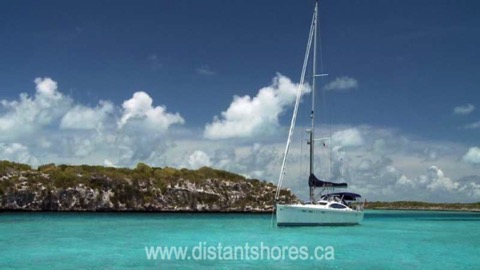
Distant Shores II anchored off Thunderball Cave, Staniel Cay, Exumas, Bahamas
Sheryl and I have been cruising for 25 years and have anchored in hundreds of places around the world in all types of conditions. We love the freedom and privacy that anchoring provides and that it allows you to stay in some amazing places that you might not be able to get to in any other way. Another perk is that anchoring saves you money compared to regularly staying in marinas.
Here are the eight steps we go through for determining if an anchorage is a good.
1. Clarify Your Personal Criteria
The first thing to do when choosing an anchorage is to clarify the reason why you want to anchor in the first place. Do you just want to anchor for lunch and a swim in a quiet place? Are there good reefs for diving or fishing close by you want to investigate? Or are you on a long-term cruise and want to anchor near towns for supplies without the expense of overnighting in marinas? Are there attractions ashore that you want to visit? Is there an anchorage near the base where you have to return your charter boat early the next morning?
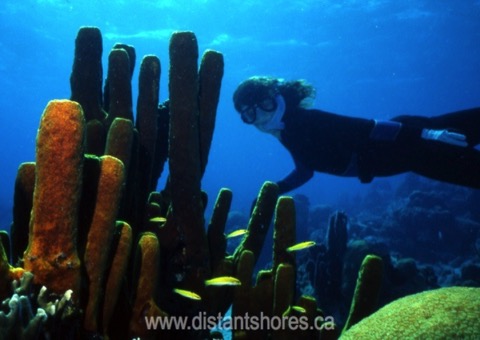
We love to snorkel so search for anchorages close to interesting shallow reefs
Often there will be several criteria when searching for ideal anchorages for you and your crew, and your criteria and needs will change throughout your voyage.
2. Check Your Charts and Cruising Guides
Once you have a rough idea of the type of anchorage you are looking for and why, a good starting point is to go over the charts and cruising guides for the area you plan to cruise in. Anchorages will be marked with the standard anchoring symbol and cruising guides will offer recommendations. However, just because they're marked as an anchorage doesn't necessarily mean they will suit you best. For example, they may be too shallow for your deep draft boat or require that you get under a bridge to get to that's too low for your mast to get under.
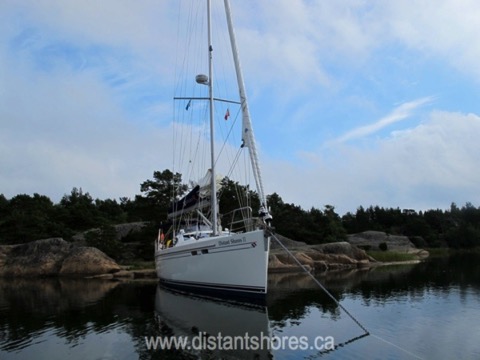
Anchored stern-to the shore in Sweden
And just because a bay or cove or spot off the shoreline isn't marked as an anchorage on the chart doesn't mean you have to rule it out as a possibility. As long as the place of your choice is not marked as a restricted area and meets the basic criteria of offering protection from wind, waves and weather; has a bottom that will provide good holding, has sufficient depth, and offers enough swinging room for your boat, it's good to go.

Anchored off Twin Cay, Exumas, Bahamas. Good in calm conditions with quiet beaches and swimming nearby.
3. Determine if There is Protection from Wind, Waves and Weather
If you anchor in a place that appeals to you, will it be protected from wind, waves and weather? This can change if there is a wind shift, increase in wind strength, or a new weather system moving in that could cause you grief. Few anchorages offer protection from all directions. Check current weather forecasts for the period of time you plan to spend there swinging on the hook to make sure you will be safe from a building swell in all predicted conditions.
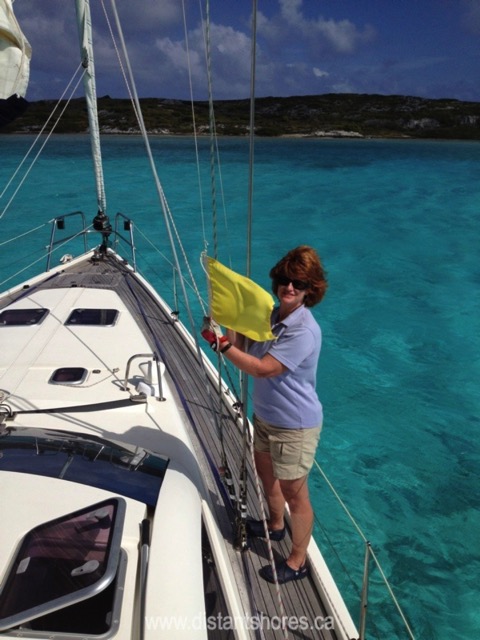
Anchored at Cockburn Harbour, South Caicos, Turks and Caicos. It’s a port of call and we needed to check in.
4. Check the Depth
Even if a harbour looks well protected, if there is too little or too much depth for your boat to anchor safely it's not worth considering. On average we find cruising guides seem to mark anchorages based on yachts with an average draft of 6 feet (1.8 m). If the draft of your boat is greater, you may have to find other options from the recommended anchorages in some cases.
You also have to consider tidal ranges if applicable. You may find sufficient water to anchor in when you first arrive but if the tide drops will you still be afloat or grounded at anchor? Best to check the tide charts in advance.
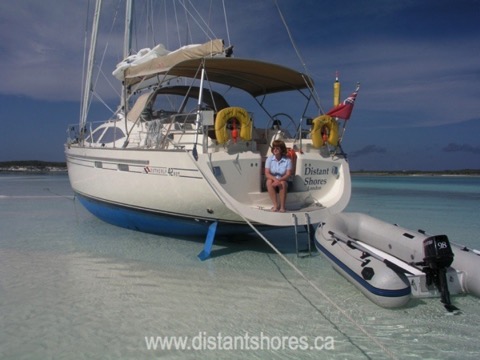
High and dry at low tide. That’s okay for Distant Shores.
Southerly Yachts are built to dry out and have retracting keels.
Too much depth can also be a problem. You may not have sufficient anchor rode to achieve the proper scope. Chain rode helps with this since the weight of the chain allows you to use less scope, but if the water is too deep and you don't have enough rode to keep a good angle on the anchor (the anchor holds better if it pulls parallel to the bottom) the anchor is likely to just pull out or drag.
5. Check the Bottom
You want to sleep through the night and not worry about your anchor dragging. Sand and mud offer the best holding properties for your anchor. This information is usually shown on charts with “S” for sand and “M” for mud. Sometimes the sketch charts in cruising guides show “good holding” or “poor holding”. Be careful of weedy areas which can cause your anchor to foul and drag, scoured bottoms where there is strong current and not much for your hook to grab into, rocky spots or areas marked “foul” where your anchor might get hung up, and areas where underwater cables are shown on the chart. In tropical areas you can often see the bottom to find a good sandy patch.
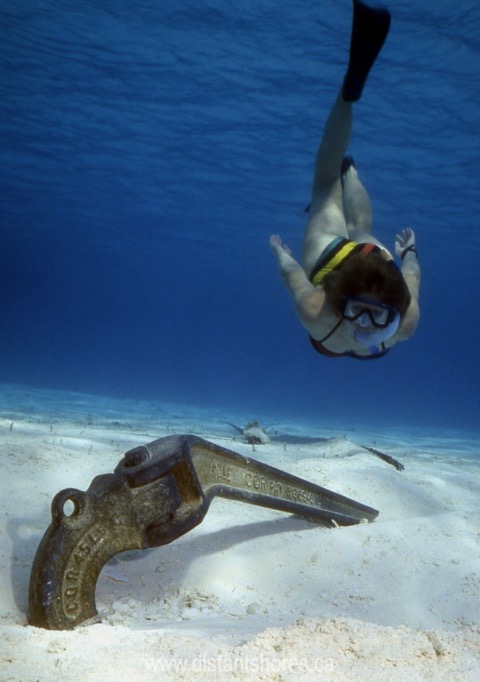
Sand provides good holding. Sheryl dives on our old CQR anchor on S/V Two-Step.
We now use Rocna anchors.
6. Determine if There is Room to Swing
Next to consider is if there is enough room for your boat to swing using the recommended five to one scope. Boats rarely sit still and with changing conditions can swing in a complete circle around the anchor. Is there room for this to happen safely or will you hit another boat or fixed object? Are you anchored near other boats that will swing the same way and at a similar speed that your boat will? For example, boats on moorings will swing in quite a small circle compared to yours at anchor. Lighter boats with more windage could swing faster than your boat creating a collision situation.
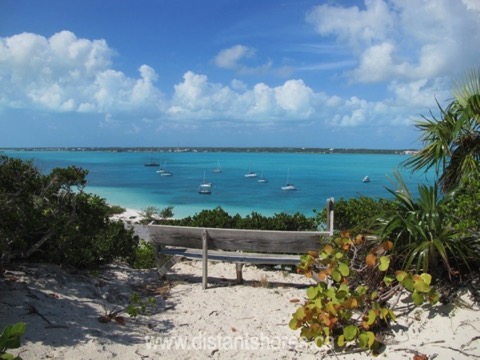
Boats anchored in Elizabeth Harbour, George Town, Great Exuma, Bahamas.
Swinging room for lots of boats here!
When Sheryl and I arrive at an anchorage where there are other boats we make it a practice to say hello to the owners of boats we might be anchoring close to, to ask how much rode they have out and if they can point to the location of their anchor. This will help you to place your anchor for safe swinging room and open up friendly discussion with fellow boaters.
7. Create a Plan B
It's always a good idea to have a Plan B up your sleeve if you get caught out. For example, you find a protected anchorage but the wind shifts. Can you simply move to the other side of the island or other end of the bay? Can you do it in the dark? Could you ride it out? Is there another anchorage or marina nearby? Will you need to head out into open water and ride it out at sea? If you can't move safely will throwing out a second anchor help you deal with increased conditions? If it's too crowded or the holding poor what's the next option?
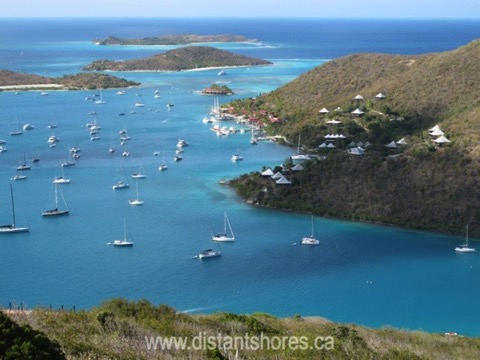
North Sound, British Virgin Islands.
Many options for anchoring or picking up a mooring off Bitter End Yacht Club and Saba Rock
8. Arrive Early
Days on the water are precious so it's tempting to pack in as much sailing and as many miles as you can in daylight hours, but arriving at an anchorage right at sunset or in the dark isn't a good idea. Then you have no time to make changes or to go to Plan B if necessary. Sometimes you'll discover your planned anchorage is too crowded for safety, or you'll find it full of lobster pots or that a fish farm has been built there since the last update of your chart! Maybe it's more developed than you'd realized or more noisy than you expected.
Arriving at an anchorage in good time reduces your stress throughout the day since you know you'll have options no matter what. Early arrival allows you time to relax, watch the anchor and feel confident that it is holding, move to a new place if it isn't, plan the next few days, cook, write, swim or do some exploring.

Lunch at anchor with friends Yvette and Pete aboard M’Lady, Isle of Wight, England
Anchoring is one of the joys of cruising, offering you fresh air, privacy, and a sense of self-sufficiency so planning it well adds greatly to your confidence and pleasure as you travel on your boat.
Explore beautiful anchorages around the world with us aboard Distant Shores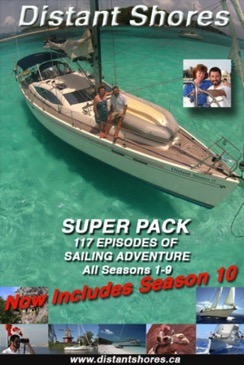
Order the Super Pack on DVD and get Season 1-10 Downloadable.
Order the Super Pack on Vimeo and we will send you the code for Season 10 as a bonus. Email us for details.